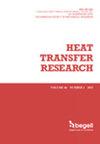Numerical investigation of the shell configuration effect on the melting of various phase change materials in the presence of porous medium and non‐Newtonian fluid
IF 1.6
4区 工程技术
Q3 THERMODYNAMICS
引用次数: 0
Abstract
By considering the ability of phase change materials (PCMs) in the storage of energy, the melting of four types PCMs including RT22, RT26, RT35, and RT41 in a heat exchanger is examined in this research. The impact of various shell cross‐sectional configurations on the complete melting time of materials, temperature changes, and liquid fraction throughout the melting process are presented. It is assumed that the main heat transfer fluid in the tube is non‐Newtonian and the tube is filled with a porous medium. The enthalpy porosity manner is applied for simulating the process of phase change and the heat natural convection and conduction cases are discussed. On the basis of the obtained results, the decrease in complete melting time is about 20% compared with the absence of a porous medium in the circular cross‐section configuration. The shell configuration has a noticeable impact on the reduction of the required time for melting. In the square cross‐section configuration, RT22 has the lowest melting time, as well as RT41 has the longest melting time in the inverted triangular cross‐section configuration in which the maximum time difference for RT22 is about 77% less. So, the best cross‐section for the shortest complete melting time is square.多孔介质和非牛顿流体存在时壳型对不同相变材料熔化影响的数值研究
考虑相变材料的储能能力,研究了RT22、RT26、RT35和RT41四种相变材料在换热器中的熔化情况。在整个熔化过程中,给出了不同壳截面构型对材料完全熔化时间、温度变化和液体分数的影响。假设管内的主要传热流体为非牛顿流体,管内充满多孔介质。采用焓孔法模拟相变过程,讨论了热自然对流和导热情况。根据得到的结果,与在圆形截面结构中不含多孔介质相比,完全熔化时间减少了约20%。壳体结构对减少所需的熔化时间有显著的影响。在方形截面结构中,RT22的熔化时间最短,而在倒三角形截面结构中,RT41的熔化时间最长,其中RT22的最大时间差约小77%。因此,最短完全熔化时间的最佳截面为方形。
本文章由计算机程序翻译,如有差异,请以英文原文为准。
求助全文
约1分钟内获得全文
求助全文
来源期刊

Heat Transfer Research
工程技术-热力学
CiteScore
3.10
自引率
23.50%
发文量
102
审稿时长
13.2 months
期刊介绍:
Heat Transfer Research (ISSN1064-2285) presents archived theoretical, applied, and experimental papers selected globally. Selected papers from technical conference proceedings and academic laboratory reports are also published. Papers are selected and reviewed by a group of expert associate editors, guided by a distinguished advisory board, and represent the best of current work in the field. Heat Transfer Research is published under an exclusive license to Begell House, Inc., in full compliance with the International Copyright Convention. Subjects covered in Heat Transfer Research encompass the entire field of heat transfer and relevant areas of fluid dynamics, including conduction, convection and radiation, phase change phenomena including boiling and solidification, heat exchanger design and testing, heat transfer in nuclear reactors, mass transfer, geothermal heat recovery, multi-scale heat transfer, heat and mass transfer in alternative energy systems, and thermophysical properties of materials.
 求助内容:
求助内容: 应助结果提醒方式:
应助结果提醒方式:


